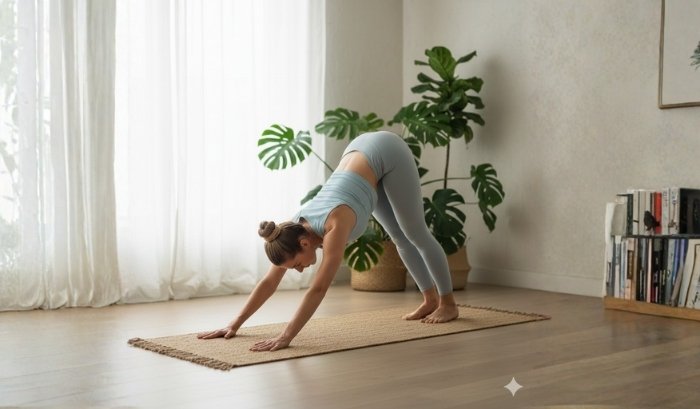Introduction
Feeling stressed or stiff is a modern-day struggle. Yoga poses for stress relief and flexibility offer a proven, holistic way to calm your mind, release tension, and improve mobility. By combining gentle movements, mindful breathing, and meditation, yoga works directly with your body’s stress systems to bring balance and ease.
Table of Contents
How Yoga Poses Reduce Stress and Improve Flexibility
Answer: Yoga targets both physical and mental stress, enhancing flexibility while calming the mind.
Stress triggers the Sympathetic Nervous System (SNS), raising cortisol, adrenaline, and norepinephrine levels. Yoga gently activates the Parasympathetic Nervous System (PNS), promoting relaxation, reducing muscle tension, and improving heart rate variability (HRV).
Key Benefits
- Stress Biomarkers: Lowered cortisol and adrenaline through regular yoga.
- Biosignals: Improved EEG patterns, stable ECG readings, and reduced GSR indicate relaxation.
- Flexibility & Mobility: Stretching asanas release tight muscles and increase range of motion.
Yoga’s Influence on the Brain and Nervous System
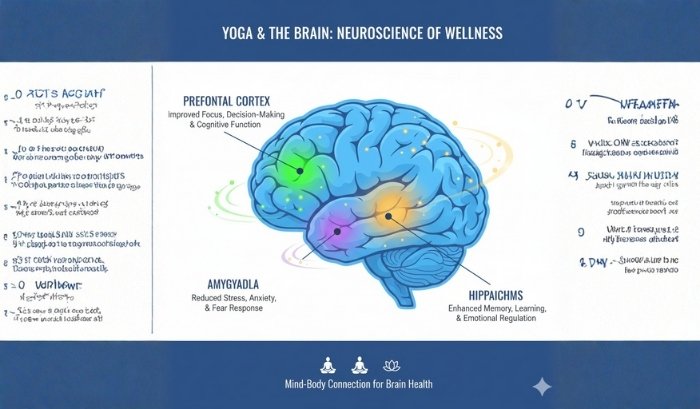
Answer: Yoga helps regulate stress by reshaping brain activity and calming neural circuits.
EEG Brainwave Insights
Yoga modifies brainwave bands that reflect stress and relaxation:
| Brainwave | Stress Role | Yoga Effect |
|---|---|---|
| Delta | Overload and fatigue | Deep rest support |
| Theta | Mental tension | Increases during meditation; promotes calm |
| Alpha | Wakeful relaxation | Boosted by OM chanting and Bhramari Pranayama |
| Beta | Overthinking | Reduced through slow breathing and gentle asanas |
| Gamma | Cognitive coordination | Enhanced with deep meditation; improves awareness |
Brain Regions Impacted
Yoga activates and calms key neural areas:
- Prefrontal Cortex (PFC): Improves decision-making and emotional regulation.
- Amygdala: Reduces fear and stress responses.
- Hippocampus: Strengthens memory and cognitive flexibility.
- Default Mode Network (DMN): Reduces rumination and overthinking.
Supporting Heart and Autonomic Nervous System Health
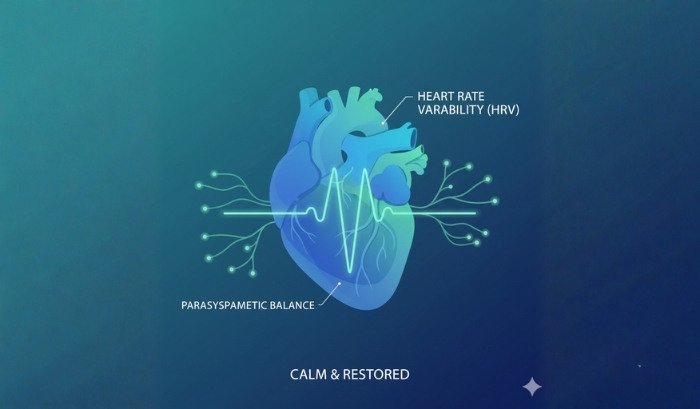
Answer: Yoga balances the autonomic nervous system and improves cardiovascular health.
- Heart Rate Variability (HRV): Increases with pranayama and asanas, indicating improved stress resilience.
- ECG Stability: Yoga reduces irregular heart rhythms under stress.
- Galvanic Skin Response (GSR): Lowered skin conductance reflects calm SNS activity.
- Muscle Relaxation (EMG): Postures relieve tension in back, shoulders, and neck.
Example: Individuals practicing Hatha yoga or Tai Chi for 8 weeks showed reduced cortisol and improved HRV.
Yoga Practices for Stress Relief and Flexibility
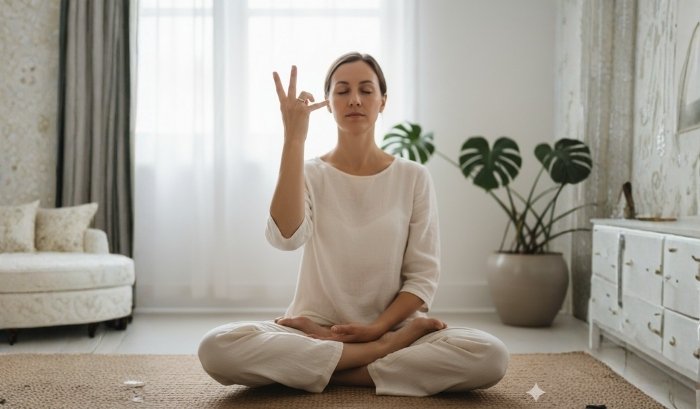
Physical Postures (Asanas)
- Downward Dog: Stretches hamstrings, shoulders; reduces tension.
- Cat-Cow Stretch: Mobilizes the spine, alleviating back stiffness.
- Warrior II: Opens hips and chest; enhances strength and focus.
Breathing Techniques (Pranayama)
- Alternate Nostril Breathing: Balances SNS and PNS, improves HRV.
- Bhramari Pranayama: Lowers anxiety, increases alpha and gamma wave activity.
- Sudarshan Kriya: Regulates stress hormones; boosts mood and focus.
Meditation Practices
- Vipassana: Enhances mindfulness, theta brainwave activity, and emotional regulation.
- Zen Meditation: Calms attention networks and reduces overactive beta waves.
- OM Chanting: Increases alpha wave activity and fosters deep relaxation.
Integrated Mind-Body Practices
- Hatha Yoga: Combines gentle asanas and pranayama for stress relief and flexibility.
- Tai Chi: Slow, flowing movements that improve balance, HRV, and muscular relaxation.
Personal Experiences: Yoga in Daily Life
Scenario 1: A software engineer practicing 20 minutes of Sudarshan Kriya daily reported calmer evenings, reduced neck tension, and better focus.
Scenario 2: A teacher with chronic stress integrated Hatha yoga for 12 weeks, noticing reduced cortisol, improved posture, and enhanced flexibility.
Scenario 3: College students using OM chanting and Bhramari Pranayama before exams experienced calmer minds and lower GSR readings.
Strengths of Yoga for Stress and Flexibility
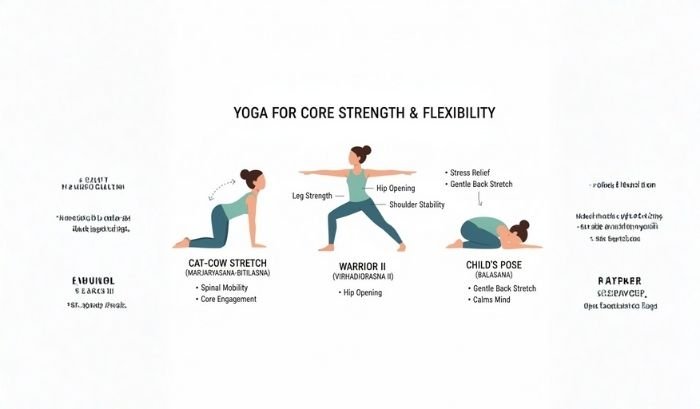
- Scientifically validated through EEG, fMRI, HRV, and GSR studies.
- Accessible and adaptable for all fitness levels.
- Combines movement, breathing, and mindfulness for holistic benefits.
- Supports emotional regulation, cognitive enhancement, and physical flexibility.
If you’re looking for professional web development, SEO services, digital marketing, content marketing, link building, or guest posting, please visit or contact LinkLuminous.com. And if you want to purchase high-quality products online, check out TokyoMart.store for great deals and a wide selection.
Areas for Improvement
- Outcomes vary depending on age, consistency, and health conditions.
- Some postures require guidance to prevent strain or injury.
- Advanced techniques like Sudarshan Kriya may not suit people with respiratory issues.
- Regular practice is needed for lasting benefits.
Comparison Table: Yoga Techniques and Their Effects
| Yoga Practice | Stress Biomarkers | Biosignals | Main Benefits |
|---|---|---|---|
| Sudarshan Kriya | Cortisol ↓, Adrenaline ↓ | EEG ↑ Alpha, GSR ↓ | Relaxation, emotional regulation |
| Bhramari Pranayama | Norepinephrine ↓ | EEG ↑ Theta & Gamma | Anxiety relief, focus |
| Hatha Yoga | Cortisol ↓ | HRV ↑, ECG stabilized | Flexibility, muscle relaxation |
| OM Chanting | Cortisol ↓ | EEG ↑ Alpha, PFC activation | Mindfulness, stress relief |
| Vipassana | Cortisol ↓ | EEG ↑ Theta, Delta | Emotional balance, cognitive clarity |
FAQ: Yoga Poses for Stress Relief and Flexibility
Q1: How quickly does yoga reduce stress?
A: Immediate relaxation is possible with breathing and meditation; consistent practice (4–8 weeks) enhances HRV, cortisol, and flexibility.
Q2: Which poses relieve neck and shoulder tension?
A: Cat-Cow and Child’s Pose effectively stretch and relax these muscles.
Q3: Can meditation alone reduce stress?
A: Yes, Vipassana or Zen meditation lowers beta activity and cortisol, though combining with asanas improves flexibility.
Q4: Is yoga safe for beginners?
A: Gentle forms like Hatha yoga or Tai Chi are beginner-friendly. Avoid advanced postures without supervision.
Q5: How does yoga support heart health?
A: Improves HRV, stabilizes ECG, reduces heart rate, and balances SNS/PNS activity.
Q6: Which breathing techniques help with anxiety?
A: Bhramari Pranayama, Alternate Nostril Breathing, and Sudarshan Kriya effectively lower adrenaline and norepinephrine.
Q7: How does yoga affect brain regions?
A: Enhances PFC, reduces Amygdala hyperactivity, strengthens Hippocampus, and modulates DMN, improving mindfulness and emotional regulation.
Conclusion
Yoga poses for stress relief and flexibility are a holistic solution for both mind and body. By influencing stress biomarkers, biosignals, and brain regions like the PFC and Amygdala, yoga fosters relaxation, emotional balance, and mobility. Start small: integrate gentle asanas, mindful breathing, and meditation into your daily routine and experience the transformation.
If you want to learn more about mental health and yoga , you can visit trusted sources like mindjournal.co, gogonihon.jp.net and ponta.in for in-depth insights and updates.
Author Bio
Dr. Aayushi Khajuria, PhD
Neuroscientist and yoga researcher specializing in stress reduction, mind-body interventions, and cognitive enhancement. Dr. Khajuria’s work uses EEG, fMRI, HRV, and GSR to validate yoga’s impact on mental health and physiological resilience.
References
- Brown RP, Gerbarg PL. Sudarshan Kriya yogic breathing in stress, anxiety, and depression. J Altern Complement Med. 2005;11:189–201.
- Streeter CC, Whitfield TH, Owen L, et al. Effects of yoga versus walking on mood, anxiety, and brain GABA levels: A randomized controlled MRS study. J Altern Complement Med. 2010;16:1145–52.
- Hartfiel N, Burton C, Rycroft-Malone J, et al. Yoga for reducing perceived stress and improving well-being in working adults: A systematic review. BMC Complement Altern Med. 2011;11:36.


